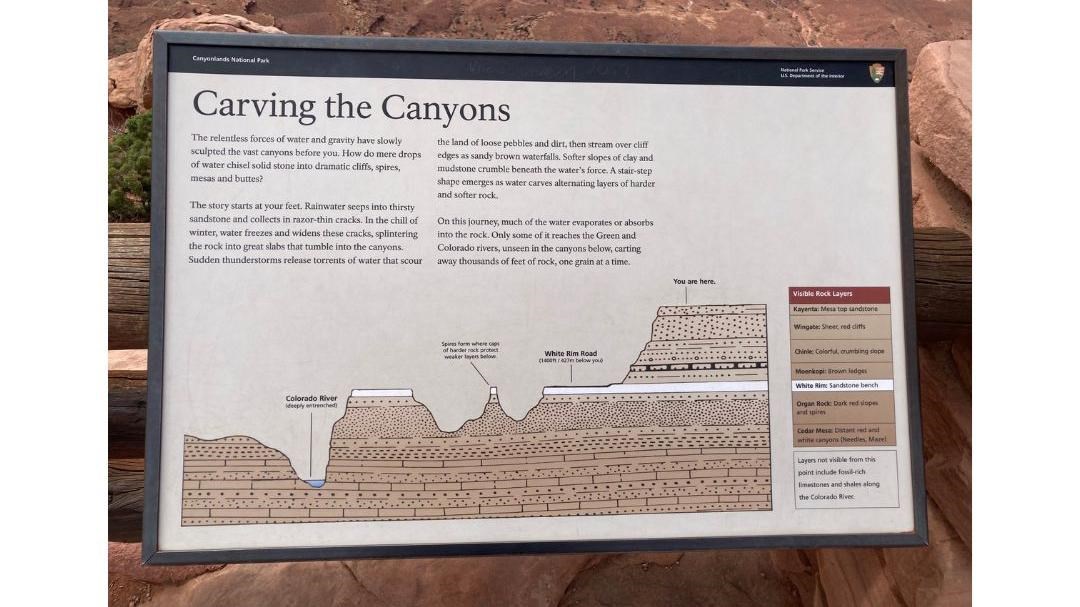Last updated: November 11, 2024
Place
Grand View Point: Carving the Canyons

NPS/J.Carver
Quick Facts
Location:
Canyonlands-Island in the Sky
Significance:
Wayside Panel
Amenities
1 listed
Historical/Interpretive Information/Exhibits
The relentless forces of water and gravity have slowly sculpted the vast canyons before you. How do mere drops of water chisel solid stone into dramatic cliffs, spires, mesas and buttes?
The story starts at your feet. Rainwater seeps into thirsty sandstone and collects in razor-thin cracks, splintering the rock into great slabs that tumble into the canyons. Sudden thunderstorms release torrents of water that scour the land of loose pebbles and dirt, then stream over cliff edges as sandy brown waterfalls. Softer slopes of clay and mudstone crumble beneath the water's force. A stair-step shape emerges as water carves alternating layers of harder and softer rock.
On this journey, much of the water evaporates or absorbs into the rock. Only some of it reaches the Green and Colorado rivers, unseen in the canyons below, carting away thousands of feet of rock, one grain at a time.
Inset: Visible Rock Layers: Kayenta: Mesa top sandstone, Wingate: Sheer, red cliffs, Chinle: Colorful, crumbling slope, Moenkopi: Brown ledges, White Rim: Sandstone bench, Organ Rock: Dark red slopes and spires, Cedar Mesa: Distant red and white canyons (Needles, Maze), Layers not visible from this point include fossil-rich limestones and shales along the Colorado River.
Graphic Captions Left to Right:
Colorado River (deeply entrenched)
Spires form where caps of harder rock protect weaker layers below.
White Rim Road (1400ft / 427m below you)
You are Here.
The story starts at your feet. Rainwater seeps into thirsty sandstone and collects in razor-thin cracks, splintering the rock into great slabs that tumble into the canyons. Sudden thunderstorms release torrents of water that scour the land of loose pebbles and dirt, then stream over cliff edges as sandy brown waterfalls. Softer slopes of clay and mudstone crumble beneath the water's force. A stair-step shape emerges as water carves alternating layers of harder and softer rock.
On this journey, much of the water evaporates or absorbs into the rock. Only some of it reaches the Green and Colorado rivers, unseen in the canyons below, carting away thousands of feet of rock, one grain at a time.
Inset: Visible Rock Layers: Kayenta: Mesa top sandstone, Wingate: Sheer, red cliffs, Chinle: Colorful, crumbling slope, Moenkopi: Brown ledges, White Rim: Sandstone bench, Organ Rock: Dark red slopes and spires, Cedar Mesa: Distant red and white canyons (Needles, Maze), Layers not visible from this point include fossil-rich limestones and shales along the Colorado River.
Graphic Captions Left to Right:
Colorado River (deeply entrenched)
Spires form where caps of harder rock protect weaker layers below.
White Rim Road (1400ft / 427m below you)
You are Here.
